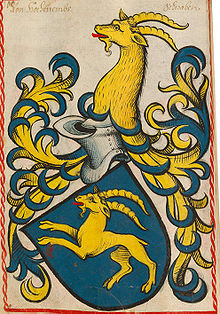Karl Friedrich von Hohenems

Karl Friedrich von Hohenems (born November 11, 1622 , † October 20, 1675 ) was a count from the noble Hohenems family . He played an important role in the development of the Principality of Liechtenstein , which still exists today , a small state in the Alpine Rhine Valley between Austria and Switzerland .
Life
Karl Friedrich von Hohenems was a son of Jakob Hannibal II von Hohenems and Princess Franziska Katharina von Hohenzollern-Hechingen and a grandson of Kaspar von Hohenems . His grandfather bought the area of today's Liechtenstein from Karl Ludwig zu Sulz in 1613. Karl Friedrich had a younger brother Franz Wilhelm I von Hohenems , a sister named Anna Katharina von Hohemems and a stepsister named Johanna Eleonore von Hohenems. He spent the years from 1637 to 1640 with his brother in Innsbruck . After the death of his father on April 10, 1646, he and his brother took control of the inherited territories. On April 9, 1647, Emperor Ferdinand III confirmed . the two brothers all their privileges and fiefs. In addition to the imperial county Hohenems , these also included the imperial direct rule Schellenberg and the county Vaduz , the fief of the archdiocese of Salzburg and the county of Gallarate near Milan in today's Italy. The brothers renounced the fiefdom of the Archdiocese of Salzburg in 1651. From 1648 to 1651 they had numerous witch trials carried out in what is now Liechtenstein. The brothers led an elaborate life, had numerous buildings built in their areas and thus got heavily in debt. Therefore they were forced to sell the county of Gallarate to the Visconti in 1654 .
In the same year they also shared their remaining dominion. Karl Friedrich became sole ruler of the County of Hohenems, while Franz Wilhelm I took over sole rule over Schellenberg and Vaduz. This division of land led to the border between Austria and Liechtenstein that still exists today.
When Franz Wilhelm I died unexpectedly in 1662 at the age of 35, Karl Friedrich and his brother's widow, Landgravine Eleonora Katharina von Fürstenberg , once again took control of Schellenberg and Vaduz because his brother's children were still too young to to take on their inheritance. It was only after his death that the legal heir Ferdinand Karl von Hohenems was able to inherit Vaduz and Schellenberg.
From 1646 to 1654 Karl Friedrich Vogt was the dominion of Feldkirch and Neuburg . In 1647 he besieged Bregenz Castle, held by Sweden , in vain during the Thirty Years' War . He lost all of his movables in the process. In 1648 he was appointed imperial colonel by Emperor Ferdinand III for his service .
There were no further successes. He tried several times to expand his dominion. So he applied in vain for the rule of Bludenz and in 1672 as governor of Vorarlberg . A purchase of the jurisdiction of Dornbirn on June 22, 1655 was rejected by the estates, and the residents of the city of Dornbirn had refused to pay homage to him. The sale had to be reversed. He tried in vain to convince the emperor to invest heavily in fortifications in his area. He wanted to create a fortified border with the Old Confederation, which was allied with France . This should significantly enhance his fortress Alt-Ems .
family
Karl Friedrich Graf von Hohenems married Cornelia Lucia di Altemps († 1691), daughter of Peter Duca di Altemps from the Italian line of the Lords of Ems . The marriage had four children:
- Maria Claudia (1646-1694)
- Franz Karl Anton (1650–1713), ruling Count of Hohenems
- Anton Josef (1652–1674), Canon in Constance
- Maria Katharina (1653–1699)
Web links
- Karl Heinz Burmeister: Hohenems, Karl Friedrich von. In: Historical Lexicon of the Principality of Liechtenstein .
literature
- Constantin von Wurzbach : Hohenembs, the counts, genealogy . In: Biographisches Lexikon des Kaiserthums Oesterreich . 9th part. Kaiserlich-Königliche Hof- und Staatsdruckerei, Vienna 1863, p. 189 ( digitized version ).
- Joseph Bergmann: The imperial counts from and to Hohenembs in Vorarlberg. Shown and illuminated in the events of their time, from 1560 to their extinction in 1759. With consideration for the female descendants of both lines from 1759–1860 , Vienna 1860, p. 111.
- Johann Heinrich Zedler : Large complete universal lexicon of all sciences and arts , Vol. 13, Hi - Hz, Leipzig 1739, p. 525.
Individual evidence
- ↑ Aron Tänzer: The story of the Jews in Tyrol and Vorarlberg , p. 33.
- ^ Hohenems, Karl Friedrich von . In: Historisches Lexikon von Liechtenstein online after BERGMANN, Die Reichsgrafen, p. 111; WURZBACH, Vol. 9, p. 189; ZEDLER, Vol. 13, p. 525.
| personal data | |
|---|---|
| SURNAME | Hohenems, Karl Friedrich von |
| BRIEF DESCRIPTION | Count from the noble family Hohenems-Vaduz |
| DATE OF BIRTH | November 11, 1622 |
| DATE OF DEATH | October 20, 1675 |